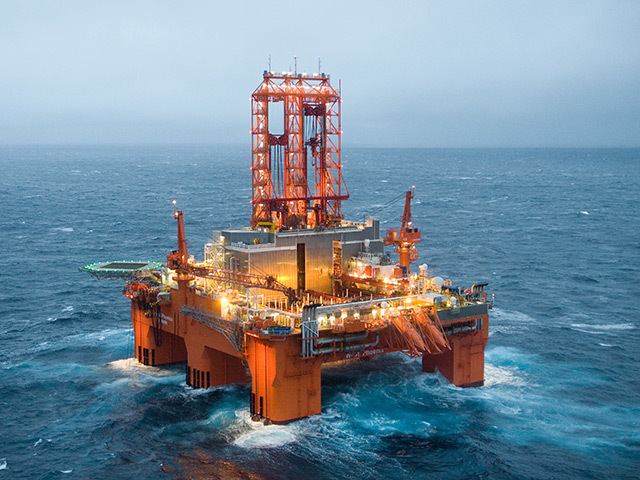
At the end of July there were eight active E&A wells in the UK (5E and 3A); one in each of West of Shetland and the Southern North Sea, and three in each of the Northern North Sea and Central North Sea. A total of 13 E&A wells have spudded to date in the UK, along with two re-spuds and two sidetracks.
West of Shetland
Nexen commenced drilling the Craster exploration well 205/15-1 on May 29 with the West Phoenix rig and is evaluating prospectivity in the Lower Cretaceous, Jurassic and Triassic to the west of the Clair Field. The next well expected to be drilled in this region is BP’s Achmelvich exploration well to the southeast of the Clair Field.
Northern North Sea
The WilPhoenix continues with Apache’s Skene exploration well, sidetracked from the main wellbore on June 22 as well 9/19c-S6Z.
In the Mariner Field, Statoil spudded two wells during July, an exploration well targeting Segment 9 and an appraisal well targeting Segment 10. Both have the same Palaeocene objectives as the Mariner Field, and are untested stratigraphic traps. The Segment 10 appraisal well drilled with the Noble Lloyd Noble was abandoned towards the end of July. Prior to this well the rig had been batch development drilling on the Mariner Field. The exploration well on Segment 9 commenced on July 5 and was sidetracked on July 20, before being abandoned shortly after. Upon completion, the Transocean Spitsbergen moved to drill the Jock Scott exploration well, 9/27-5, also for Statoil. The well spudded on July 28 and is targeting the Upper Jurassic, with operations expected to be completed by early September.
Central North Sea
Maersk spudded Yeoman appraisal well 15/18b-14 on July 1 with the Ocean Valiant semi-submersible where it is seeking to prove commercial resources in the Palaeocene. A successful result could lead to a tie-back to the Dumbarton Field FPSO around 25km to the southeast.
Summit spudded Avalon appraisal well 21/6b-9 on June 22, before then abandoning the well in July and moving the Stena Spey rig to drill its Ranger exploration well, 15/16d-27, which spudded on July 15 and was active at month-end. It is understood that the Avalon appraisal well encountered hydrocarbons, however any declaration of commerciality will have to await post-well analysis. Nexen spudded the HPHT Glengorm exploration well, 22/21c-12, on July 12 with the Maersk Gallant jack-up rig, where it is targeting prospectivity in the Upper Jurassic. The well has been re-spudded for mechanical reasons and, assuming no further delays, the expected duration is around 150 days.
Southern North Sea
Wintershall is drilling an appraisal well on the Winchelsea Discovery that was made in 2016. The well commenced on July 6 with the jack-up Maersk Resolve. Resources are estimated at 150 bcf in the Carboniferous, and positive results could lead to a tie-back development via the operator’s nearby Wingate Field. The well has an expected duration of around 80 days.
NORWAY
As predicted, the number of E&A wells drilling in the UK has increased substantially. Only three spudded between January and May, but there have been 10 new spuds within the last two months. Of all the wells that have commenced in the UK this year, eight were subject to attempted farm-out. Summit was successful in securing a farminee for both its Avalon and Ranger wells, whilst Nexen was successful in farming-out the Craster well to BP. Statoil has secured BP as a farminee for the Jock Scott exploration well that spudded at the end of July.
The spudding of the only well in July, on the Gemini North Prospect, means the number of E&A well starts in Norway for 2017 is now 13, matching the UK. There were two active wells at the end of July, with completions during the month on the Blåmann and Kayak exploration wells and the Brasse appraisal well.
At the same point in 2016, there had been eight more E&A wells starts and this shows how activity levels have fallen in the intervening 12 months. There will need to be a doubling of the August to December 2016 drilling levels in 2017 if activity is to have any chance of equalling what were already poor levels of activity in 2016, when there were 28 well starts.
North Sea
Faroe announced the completion of its Brasse appraisal programme, with the Deepsea Bergen (SS) on July 26. Well 31/7-2 S was geologically sidetracked as Well 31/7-2 A. The initial well encountered a 9m oil column, and the subsequent sidetrack well encountered an 18m oil column and a 4m gas column in good to very good reservoir quality Upper Jurassic Sognefjord Formation sandstones. The OWC was the same as in discovery Well 31/7-1. The result has led to an increase in the resource estimate by 15–30% to 56-92 mmboe, as well as increasing production rate expectations.
Norwegian Sea
There has been no activity since Repsol’s Stordal Prospect dry hole in May. The next planned is Statoil operated Well 6507/8-9, expected to start within two months targeting the Middle Jurassic Carmen Prospect, to the northeast of Heidrun Field.
Barents Sea
Statoil announced Well 7219/9-2 on the Lower Cretaceous Kayak Prospect as a discovery. It lies 22km south west of Johan Castberg, drilled with the Songa Enabler (SS). Oil was found within two moderate to poor quality sandstone intervals of the Kolje Formation, and the discovery is being assessed for its potential to be tied-back to Johan Castberg. The discovery was followed by Well 7121/8-1, which made the Blåmann gas discovery, between the Goliat and Snøhvit fields. Drilling operations on Well 7121/8-1 had originally been suspended near the start of June due to a legal dispute. Elsewhere, Lundin is continuing operations with the Leiv Eiriksson (SS) rig on appraisal sidetrack Well 7220/11-4 A, having confirmed communication with the Alta Discovery Well 7220/11-4 and successfully tested 6,050 boepd.
Recommended for you
